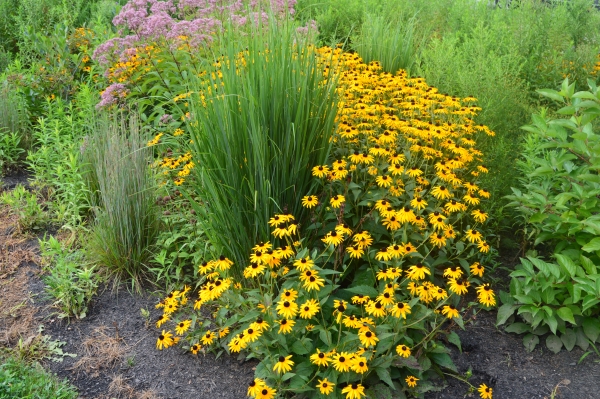By Pamela Doan
My lawn has never been so lush and green. Data from Hudson Valley Weather, a useful source for forecasts and statistics, shows that 2018 was only rivaled by 2011 for the wettest period from July to September, and most of the rain in 2011 came from two tropical storms, Irene and Lee. Even without major storms, we’ve had a lot of rainy days this year — 40 of 92 in those three months.
I’m concerned with runoff from my Philipstown yard and soil erosion on this rocky landscape. Even though I garden organically and don’t use pesticides, herbicides or chemical fertilizers, any substance on my property — oil leaking from a car, gas that spills when the lawn mower is filled, paint spills — can get washed into a waterway. Natural collection points like a rain garden or swale let that water filter into the ground, where it can be cleansed.

I posted in several social media groups asking for firsthand experiences with these landscape features and didn’t get a single reply. Like me, I expect many gardeners are intimidated by drainage. If you don’t have standing water in the yard, there’s no reason to act.
Climate change is a reason, however. The past few years have demonstrated what we can anticipate more intensely in the future: More rainfall, but in less frequent events, which means heavy downpours followed by long periods without rain, combined with hotter temperatures. These are not ideal growing conditions for most plants.
Here are some of the ways that rain gardens and swales can benefit your landscape and the surrounding environment:
Prevent erosion
During heavy rainfalls, soil is more likely to be washed away. Bare soil is most at risk, but even soil that’s held in by shallow rooted plants is vulnerable. By some estimates, we’ve lost more than half of the earth’s surface layers of soil already. These are fertile layers for planting and carbon storage.
Filter stormwater
Whether from a heavy rainfall or snow melt, when there’s a lot of water flowing through the landscape, rain gardens and swales can hold the water in one place to let it filter into the ground.
Prevent flooding
You can divert water away from a home or building and keep stormwater from contributing to the flooding of lakes and rivers.
While there are many ways to approach creating a rain garden or swale, including native plants is effective. Many plants thrive in wetter conditions even though they aren’t wetland plants that grow in water. Joe pye weed (Eutrochium purpureum) is one example. When I asked Bryan Quinn, environmental designer at One Nature in Beacon, for recommendations, he raised a point I hadn’t considered.
“Don’t put plants along the bottom that can get knocked off by flow,” he advised. “For example, vines are creepers and can become dislodged. Thinly stalked plants, wispy plants and spring ephemerals also couldn’t handle it.” Quinn suggests native grasses like little bluestem (Schizachyrium scoparium), rushes, sedges and switchgrass (Panicum virgatum).
Living on a steep slope where I’ve seen a frightening amount of rainfall flow downhill toward my home during storms, I wondered if a swale system could keep my house from sliding off the mountain someday. Quinn told me that preparing for that 500-year storm would require a professional designer.
While the specific conditions of every site need to be considered, creating a rain garden is an easy first step and there are general guidelines. An obvious location is an area of your yard that stays soggy after it rains. Don’t place it close to a building foundation or septic system. Quinn also mentioned to be careful that you’re not sending water to your neighbor’s yard.
A rain garden can be as simple as a shallow depression no less than 4 inches deep and no more than 8 inches deep (then it becomes a pond). Along the edge of a property where water flows into the road is a good spot, as is the point where water flows off a driveway or other hard surface. Make it look good; this is a feature and should be planted with aesthetics in mind. Buttonbush (Cephalanthus occidentalis) and summersweet (Clethra alnifolia) are lovely shrubs that can be included. Other native perennials are swamp milkweed (Asclepias incarnate) bottle gentian (Gentiana clausa) and boneset (Eupatorium perfoliatum).
Pamela Doan, a garden coach with One Nature, has grown ferns in Seattle, corn on a Brooklyn rooftop and is now trying to cultivate shitake mushrooms on logs. Email her at [email protected].
